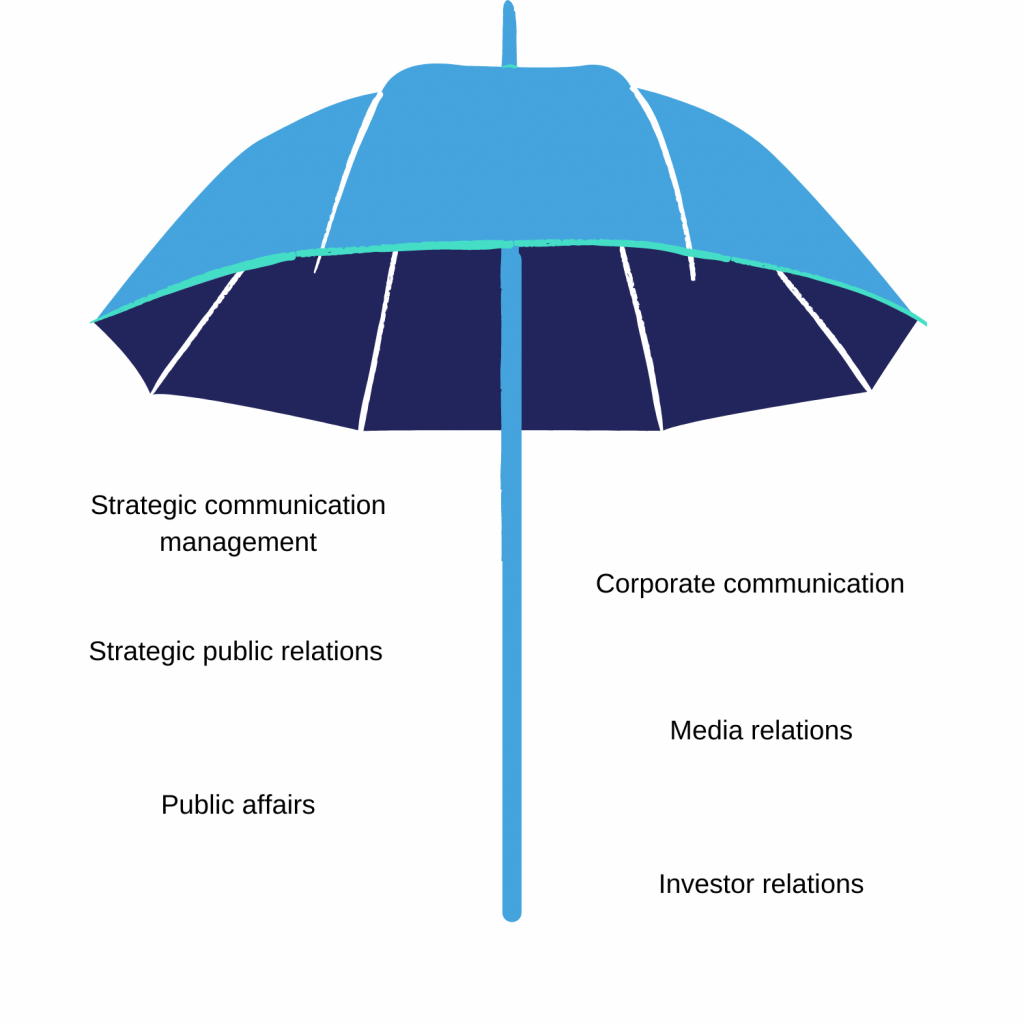2 What is Public Relations?
You may be wondering what public relations (PR) really means, and what public relations professionals really do. Very few people recognize how important public relations is for organizations. Popular TV shows like Mad Men or Sex and the City have influenced public’s perception of public relations. Robert Wynne, the owner of a public relations agency, says that he constantly has to explain to his clients that they don’t, like advertisers, buy advertisements, or pay journalists to write stories. On the contrary, they use trusted, unpaid sources or earned channels to communicate with external or internal audiences.
Public relations professionals are storytellers as well as listeners. They create narratives to facilitate conversations among various groups in the society in order to initiate positive perception of an organization. They also listen to people’s sentiments across various platforms to identify problems and protect the reputation of an organization. Public relations professionals monitor issues on an ongoing basis to prevent crises or mitigate damage from a crisis.
Image Hotspots: Multiple roles of a public relations professional
In Canada, public relations is a fast-growing industry which has many jobs to fill and professional advancement opportunities. Public relations popularity is growing each year. You can find a public relations department virtually in every big company, as well as in government and non-profit organizations.
Due to the increasing demand for PR professionals, many universities and colleges in Canada offer public relations degree programs. Among them, the Bachelor of Public Relations degree at MSVU (which recently celebrated its 40th anniversary) is known as the flagship undergraduate degree PR program in Canada.
Public relations practitioners all over the world have professional organizations to support their interests, and facilitate innovation and communication between members. For example, the International Public Relations Association (IPRA) and the Public Relations Society of America (PRSA) help their members in the ethical practice of public relations and succeed in the field by providing them with the opportunities for professional development, networking and leadership.
In Canada, the Canadian Public Relations Society (CPRS) supports the interests of people who practice PR and serve the public good. Its members “work to maintain the highest standards and to share a uniquely Canadian experience in public relations” (CPRS, 2022).
Public relations is not all too easy to define because the profession is constantly evolving due to changes in the society and technology. J. Grunig and Hunt’s definition of public relations is one of the best-known and widely cited.
Public relations is “the management of communication between an organization and its publics” (Grunig & Hunt, 1984 p.4).
This definition emphasises that, unlike journalism or advertising, public relations has a unique management function which is based on research and strategy. The definition incorporates four most important terms that describe public relations:

Management is “a distinct process consisting of planning, organising, actuating and controlling; utilising in each both science and art, and followed in order to accomplish pre-determined objectives.” Terry (1971, p. 4)

Communication “focuses on how people use messages to generate meanings within and across various contexts” (NCA, 2022, para 1).

Organization is a group of people united for a common purpose; it can be a company, a business, a firm, a corporation, a political party, a governmental agency, or a non-profit group.

Publics are any groups of people who have real or potential interest in an organization. In public relations, we use the term “publics” to describe groups of people with common interests, while “the public” can mean people in general. Publics differ from stakeholders. Stakeholders are a group of people with a stake in organization. External stakeholders are those publics that are not directly connected with the organization. Examples of an organizational external stakeholders include government, customers, clients, industry associations, trade associations, suppliers, the media, bankers, interest groups, educators, and the community. Internal stakeholders are those publics who are directly connected to an organization, such as, employees, board members, advisory boards, etc. Targeted audiences are publics who receive targeted messages that resonates with them.
A more modern definition adopted by PRSA defines public relations as “a strategic communication process.” This definition emphasizes the importance of strategic communication in building “mutually beneficial relationships between organizations and their publics” (PRSA, 2022).
The Canadian Public Relations Society (CPRS) defines public relations as “the strategic management of relationships between an organization and its diverse publics, through the use of communication, to achieve mutual understanding, realize organizational goals and serve the public interest (Flynn, Gregory & Valin, 2008).
One significant difference between the Grunig and Hunt’s definition and this more contemporary definition adopted by CPRS is the addition of the concept of serving the public interest. Although the CPRS definition also emphasizes the management function of public relations and the relationship between organization and public, it further highlights the social utility of public relations by emphasizing that this function must serve not only the organization, but also the public interest.
Recent research on Canadian public relations reveals some interesting trends in the field. The responsibility for social media management and social media messaging rests firmly in the hands of organizational public relations departments. In fact, managing social media has emerged as one of top priorities for public relations practitioners, along with organizational communication and providing strategic communication advice to organizational decision-makers (Thurlow, et al., 2018).
According to the PRSA, public relations also encompasses the following:
- “Anticipating, analyzing and interpreting public opinion, attitudes and issues that might have an impact, for good or ill, on the operations and plans of the organization.
- Counseling management at all levels in the organization with regard to policy decisions, courses of action and communications – including crisis communications — taking into account their public ramifications and the organization’s social or citizenship responsibilities.
- Protecting the reputation of an organization.
- Researching, conducting and evaluating, on a continuing basis, programs of action and communications to achieve the informed public understanding necessary to the success of an organization’s aims. These may include marketing; financial; fundraising; employee, community or government relations; and other programs.
- Planning and implementing the organization’s efforts to influence or change public policy.
- Setting objectives, planning, budgeting, recruiting and training staff, developing facilities — in short, managing the resources needed to perform all of the above.
- Overseeing the creation of content to drive customer engagement and generate leads.” (PRSA, 2022)
Several fields exist within public relations, such as crisis communication, internal communication, investor relations, media relations, speechwriting, brand journalism, and event planning.
There are a lot of terms associated with public relations practice. These terms may create confusion about public relations functions within an organization. To avoid this confusion, we will discuss some of them in this chapter.
The term corporate communication is the most popular synonym for public relations, followed by strategic communication, marketing communication and public affairs. Corporate communication is a broad term that refers to the way in which for-profit organizations communicate with internal and external stakeholders. Many professionals even consider public relations to be a function of corporate communication. Professionals prefer to use the term corporate communication, whereas the term public relations is more popular among academics.
Strategic communication is an umbrella term used for various communication-related professions, such as public relations, marketing communication, advertising, etc. Strategic communication is “the purposeful use of communication by an organization to fulfill its mission” (Hallahan et al., 2007, p. 3).
Marketing communication focuses on how for-profit organizations communicate messages to their desired market about product launches, promotions, special campaigns, and branding. Marketing communication is often referred as a field or sub-specialty within public relations.
Another commonly used synonym for public relations is public affairs. Public affairs relate to the matters of public interest or concern, such as current social and political issues, legislation, and public administration. Public affairs departments are typically found in government agencies and non-profit organizations.
Whatever name you come across for public relations, it is a thriving field based on theoretical and applied research, and professional practice.

References
Canadian Public Relations Society. (n.d.). About. Retrieved from www.cprs.ca/About.aspx
Flynn, T., Gregory, F., & Valin, J. (2008). CPRS public relations definition and values. Retrieved from http://www.cprs.ca/aboutus/mission.aspx
Grunig, J. E., & Hunt, T. (1984). Managing public relations. New York: Holt, Rinehart and Winston.
Hallahan, K., Holtzhausen, D., van Ruler, B., Vercic, D., Sriramesh, K. (2007). Defining strategic communication. International Journal of Strategic Communication, 1(1), 3-35. https://doi.org/10.1080/15531180701285244
National Communication Association. (n.d.). What is communication? https://www.natcom.org/about-nca/what-communication
Public Relations Society of America. (n.d.). Public relations defined. Retrieved from https://www.prsa.org/about/all-about-pr
Thurlow, A., Kushniryk, A. Blotnicki, K. & Yue, A. (2018). Roles, decision making and access to the dominant coalition: The practice of public relations in Canada. Journal of Professional Communication, 5(2), 41-58
Terry, G. R. (1971). Principles of Management, 6th edition.
Wynne, R. (2016, January). Five things everyone should know about public relations, Forbes. Retrieved from https://www.forbes.com/sites/robertwynne/2016/01/21/five-things-everyone-should-know-about-public-relations/?sh=db962102a2c1
According to CPRS, public relations is the strategic management of relationships between an organization and its diverse publics, through the use of communication, to achieve mutual understanding, realize organizational goals and serve the public interest.

